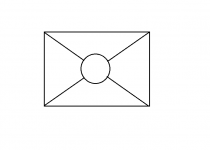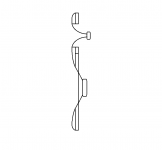I think you need small vent holes for midrange, placed close to tweeter, to make the two drivers work together properly
which may leave you pressure issues
I would forget about unity this way
unless its for a cheap disco where noone cares
which may leave you pressure issues
I would forget about unity this way
unless its for a cheap disco where noone cares
I don't want to be a troll with my continues nagging about patternflip. Just want to learn more about horns and look stupid in the proces of doing so  .
.
So going from the Autotech Iwata and Yuichi recommended crossover points, making a short visit at the complete Klipsch Heritage line and ending up with recent horns like the Vittora and Vox Olympian. Is patternflip really that bad? Please understand i have problems putting 1+1 together. Either patternflip is really bad or the above mentioned designs are really bad. I am confused.
 .
. So going from the Autotech Iwata and Yuichi recommended crossover points, making a short visit at the complete Klipsch Heritage line and ending up with recent horns like the Vittora and Vox Olympian. Is patternflip really that bad? Please understand i have problems putting 1+1 together. Either patternflip is really bad or the above mentioned designs are really bad. I am confused.
One quick reality check would be the portlength needed 🙂 Or you could go sealed.
Yes, I was intending on the cabinet itself being sealed...but without a second driver it would effectively be a vented enclosure 🙂 I wanted to make sure that if I'm using the driver in that way that it would 'just work', or that I'd need to put something in to keep it sealed.
unaHm,
If you look a bit more into the Synergy, you will find that this design works well with cheaper closed backed midrange speakers. For the price of an extra Alpha 8 you could end up with a full 2 or 4 mid Synergy and maybe use the Alpha 8 in folded horn below 🙂
If you look a bit more into the Synergy, you will find that this design works well with cheaper closed backed midrange speakers. For the price of an extra Alpha 8 you could end up with a full 2 or 4 mid Synergy and maybe use the Alpha 8 in folded horn below 🙂
you can get a nice 1" SEOS-12 waveguide from PartsExpress
just mount it with the Alpha-8 in a nice big flat baffle
maybe open, or mounted with a closed box on the back
might be very difficult to do better
just mount it with the Alpha-8 in a nice big flat baffle
maybe open, or mounted with a closed box on the back
might be very difficult to do better
you can get a nice 1" SEOS-12 waveguide from PartsExpress
just mount it with the Alpha-8 in a nice big flat baffle
maybe open, or mounted with a closed box on the back
might be very difficult to do better
Interesting! I know that waveguides have been part of the discussion for a while.
I have wood that I can cut, and time (kind of). Can I make my own, or are the curves on the waveguide panels too exact to be done by hand?
Also, can the curves for the waveguides be calculated in any software at the moment?
Last edited:
its relative easy to make a flat waveguide for the Alpha-8, if thats what you want
less is better 😉
but not absolutely needed either
as for the tweeter(compression driver), the entry/exit hole allignment is very important
it must be absolutely 100% smooth
many of the new plastic waveguides/horns have been improved quite a lot, according our debates here
and they are cheap, so I don't think its worth the trouble to build that one
btw ... getting tweeter and midrange driver mounted close together could be one of the main priorities to achieve the best result 😉
unfortunately a midrange waveguide drives it the opposite way
the SEOS-12 horn/waveguide would be very good in this respect
but there are others too, QSC or maybe FaitalPro
less is better 😉
but not absolutely needed either
as for the tweeter(compression driver), the entry/exit hole allignment is very important
it must be absolutely 100% smooth
many of the new plastic waveguides/horns have been improved quite a lot, according our debates here
and they are cheap, so I don't think its worth the trouble to build that one
btw ... getting tweeter and midrange driver mounted close together could be one of the main priorities to achieve the best result 😉
unfortunately a midrange waveguide drives it the opposite way
the SEOS-12 horn/waveguide would be very good in this respect
but there are others too, QSC or maybe FaitalPro
Less is definitely better! Especially for my sanity 🙂
If it's easier just to make a waveguide for the Alpha 8, and keep the tweeters separate, then that's what I can do.
Are there any threads on waveguide design here? Is there a WaveGuideResp? 😉
If it's easier just to make a waveguide for the Alpha 8, and keep the tweeters separate, then that's what I can do.
Are there any threads on waveguide design here? Is there a WaveGuideResp? 😉
Thanks 🙂
So is the throat of your waveguide still 1 inch?
How do you determine the flare of the waveguide, and its depth?
So is the throat of your waveguide still 1 inch?
How do you determine the flare of the waveguide, and its depth?
just follow the angle of the driver cone, or a bit less
you will need to do some shaping around the driver hole, to make it smooth
you will know once you see it in front of you
(driver mounted from the back)
it is always a good idea to make smaller model first
but might be a good idea to start shaping the driver hole
and the build the waveguide on that
you will need to do some shaping around the driver hole, to make it smooth
you will know once you see it in front of you
(driver mounted from the back)
it is always a good idea to make smaller model first
but might be a good idea to start shaping the driver hole
and the build the waveguide on that
Attachments
I see - so it makes the speaker appear 'bigger' than its actual size.
How far do I follow the path of the cone?
What determines the depth of the waveguide - is it related to a particular resonant frequency that the size of the mouth has to meet?
How far do I follow the path of the cone?
What determines the depth of the waveguide - is it related to a particular resonant frequency that the size of the mouth has to meet?
What determines the depth of the waveguide ...
make it same depth as the cone, more or less
does not need to be very accurate
just avoid it becomes a horn 😀
that is for mounting from the back, and mostly to smoothen the transistion
but mounted from the front and countersunk on a flat baffle more or less does the same
this way it will also be possible to mount yet another shaped baffle in front of the mounted driver
this attached baffle could also hold the tweeter horn
Attachments
the main key to this is a smooth surface without diffraction problems
all edges gives diffraction, even the smalles ones, like a simple screw head, or the edge og driver frame, etc
all edges gives diffraction, even the smalles ones, like a simple screw head, or the edge og driver frame, etc
I'll put a picture online tomorrow, but here are the details:
The cone expands from 1.5" to 6" over the course of 2" in height.
If I start the waveguide's throat at 6", over the next 2" in height (as tinitus had mentioned to match the height of the waveguide to that of the cone), the waveguide will expand to a 10.5" diameter.
It seems rather small and unassuming in comparison to the example you gave tinitus! Maybe that's all I need though...
Either patternflip is really bad or the above mentioned designs are really bad. I am confused.
'Sound is round', so anything that distorts a sound 'bubble' is technically bad, ergo pattern flip is really bad since it audibly 'colors' the sound enough for us relatively hearing impaired humans to perceive it and why the pioneers concluded that the max acceptable wave 'distortion' was to convert it to square of the same area or rectangular where one set of parallel walls are 1/4 WL for a ~1:1.2732 aspect ratio.
GM
Thanks GM!
That is some solid info, especially the 1/4 WL and aspect ratio part is very welcome. I am trying to get a grip on center to center distance vs paternflip. If i choose a round horn center to center will be large -> listening distance has to be larger -> sweetspot smaller (relative angles). If i choose rectangular center to center can be closer > i can make the sweetspot larger > use a 90 x 40 horn or profile. As you may have noticed i was a bit torn between the two...
So if i understand this correctly the max aspect ratio of a rectangular horn is set by this 1:1.2732 ratio? I am still a hornnoob, my brain /understanding things works better with picture's. Could you perhaps provide me with link(s) or picture so i can learn more about this? This would be unacaptable? Really do apreciate these answers!
Denovo SEOS-12 Waveguide 2/3 Bolt Matte with Adapter | 300-7070
That is some solid info, especially the 1/4 WL and aspect ratio part is very welcome. I am trying to get a grip on center to center distance vs paternflip. If i choose a round horn center to center will be large -> listening distance has to be larger -> sweetspot smaller (relative angles). If i choose rectangular center to center can be closer > i can make the sweetspot larger > use a 90 x 40 horn or profile. As you may have noticed i was a bit torn between the two...
So if i understand this correctly the max aspect ratio of a rectangular horn is set by this 1:1.2732 ratio? I am still a hornnoob, my brain /understanding things works better with picture's. Could you perhaps provide me with link(s) or picture so i can learn more about this? This would be unacaptable? Really do apreciate these answers!
Denovo SEOS-12 Waveguide 2/3 Bolt Matte with Adapter | 300-7070
- Status
- Not open for further replies.
- Home
- Loudspeakers
- Multi-Way
- Midbass horn



